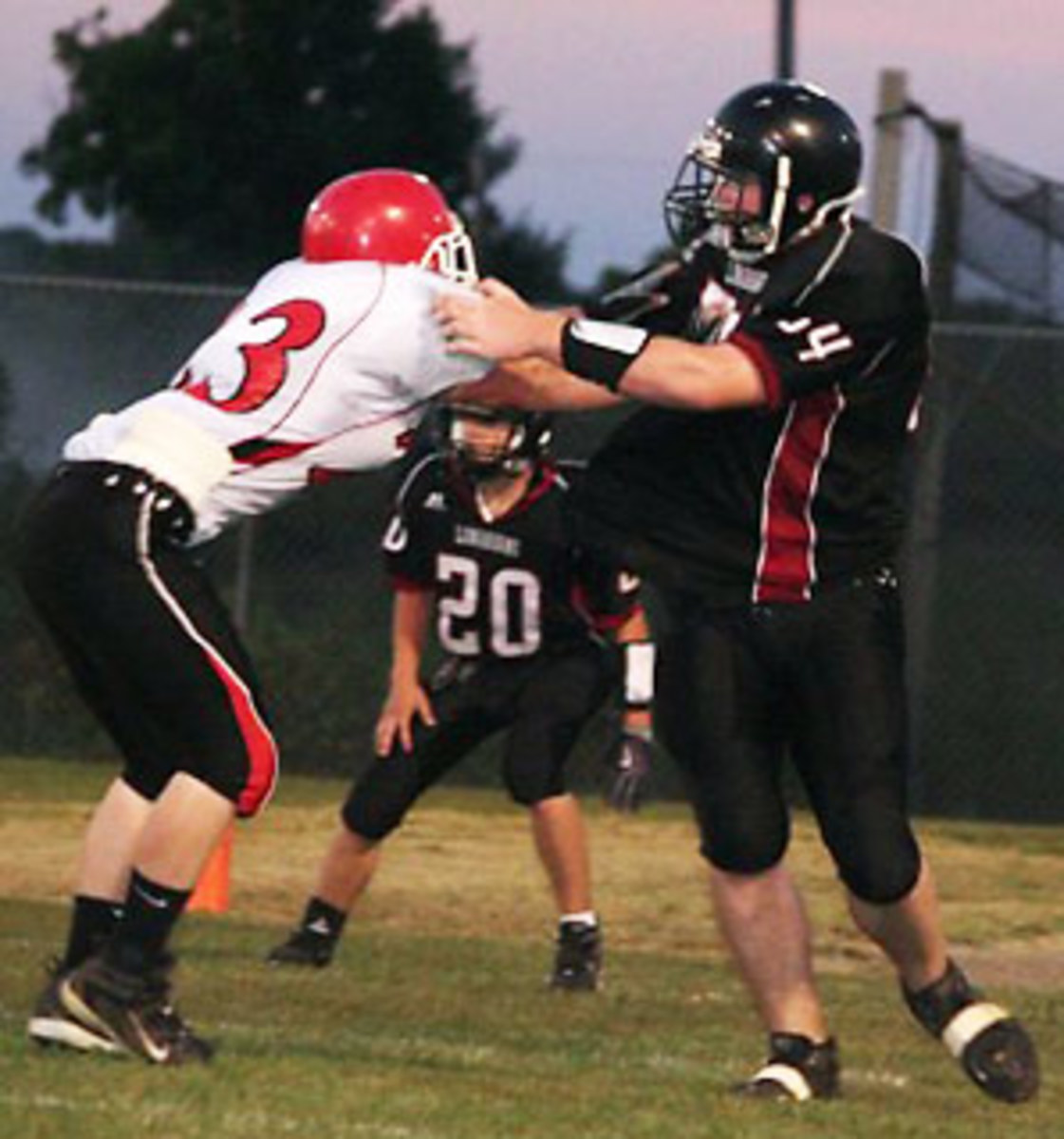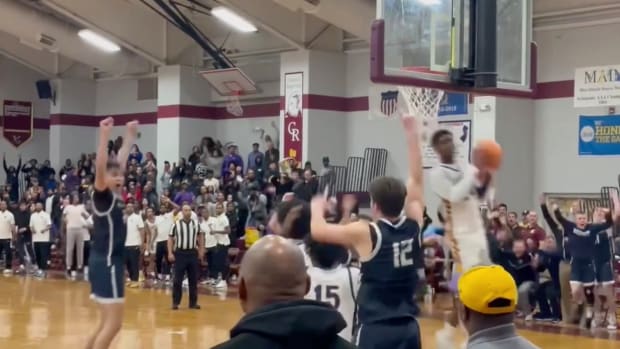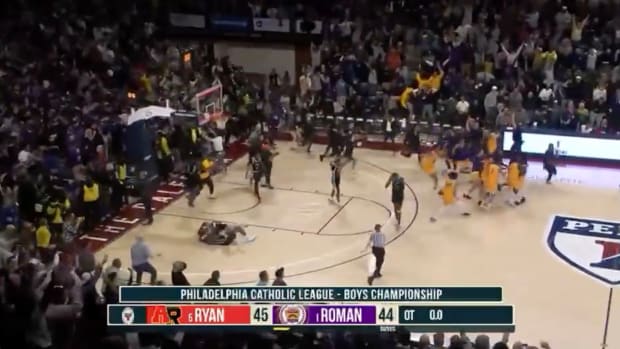For eight-man recruits like Zach Hilsabeck, there are no guarantees
He went from a town of 257 to a stadium that seats 71,000. It was a different world: the towering bleachers, state-of-the art workout room, sprawling campus and pristine practice field. But one thing stood out, newer than the rest.
As his shoe touched the ground, something felt a bit off. The grass was stiffer. It was thicker and hotter. It soon became apparent: Zach Hilsabeck had never seen an artificial field before.
A senior at South Nodaway High in Barnard, Mo., Hilsabeck traveled to Columbia, Mo., the past two summers for the University of Missouri's annual camp for recruits. The 6-foot-7, 310-pound offensive lineman was one of many oversized prospects in attendance. In his pads, he looked the same as the player next to him. What made Hilsabeck different wasn't so readily apparent.
He hesitated at the line of scrimmage, tentatively shuffling into position. In these instances, he gave himself away. For all of high school, Hilsabeck played strictly eight-man football.
Eight-man football is a variation of football that eliminates three players on both sides of the ball, typically losing a receiver and two tackles on offense and a lineman and two backs on defense. The game is an ideal solution for towns with high school classes too small to field full-sized teams, with rosters commonly as thin as just 10 or 11 players.
The eight-man game originated in Nebraska during the Depression and has spread throughout the country in the nearly 80 years since. Once confined to the Midwest and Plains, eight-man teams have sprung up in 32 states -- predominantly rural areas -- from California to South Carolina. And popularity is growing. Since 2004, the number of teams playing with fewer than 11 men (six-, eight- and nine-man teams) has increased by 28 percent, from 1,132 to 1,447, and that doesn't include teams not officially recognized by high school athletic associations. In places like Alaska and Hawaii, teams have formed as a way to hold onto the sport as enrollment numbers dwindle.
In a way, eight-man football is a game in flux. Strict enrollment caps can force teams to switch between eight- and 11-man ball when class sizes are evaluated every two years. School closings and mergers in rural areas serve as death sentences to eight-man programs. Perhaps most pressing, eight-man football is repeatedly haunted by the same controversial question: Is it truly football?
It's tough to answer. Is eight-man the game played by programs like Dewar High in Oklahoma, the perennial powerhouse responsible for Scout.com's No. 41 prospect in 2008 and current Sooner defensive end Ronnell Lewis? Or is it a second-rate game reserved for small Christian schools and alliances of home-schooled players? Regardless of the spectrum of talent, the issue continues to be raised.
It also plagues the most talented players on eight-man teams as they begin the recruiting process, if they begin the recruiting process. Some, like Lewis, have attracted national attention. But Hilsabeck and hundreds like him are stuck, walled in not only by miles of fields and pothole-studded two-lane highways, but also by a decades-old precedent. Talented eight-man players play for Division I-AA and Division II teams. The special ones, the local legends, have the potential to walk on at Division I schools. But persuading coaches and recruiting coordinators to take risks on eight-man players always seems to be a challenge, and without scholarships, the highways out of town can seem bumpier than ever.
Theron Troxel, coach of an eight-man team at Freeman High in Adams, Neb., can relate. A native of Coleridge, Neb. (population 473), Troxel played eight-man football in high school before walking on at Nebraska in 1995. He concedes the move from a little-known speck on the map to a bustling college town was difficult. "My dorm was bigger than my town, double the size of the town I grew up in," he said.
Lewis feels the same way, noting the distance between his hometown of Dewar (population 1,029) and Norman seemed much larger than the roughly 100 miles separating the two.
Ultimately, Lewis and Troxel adjusted to Norman and Lincoln more smoothly than expected. The bigger obstacle was finding a role on their new teams, transitioning from an once-in-a-lifetime player to one in a million. It's a problem common among former eight-man stars.
The top players on eight-man teams often play every snap. The talent pool is shallower, making an all-star player a team's most coveted asset. "When I played in high school, I'd be the center one play, the guard the next play, tight end one play, fullback the next play," Troxel said. "I was a punter and kicker, defensive tackle, middle linebacker. I never went out."
It's a grueling workload that makes games seem like decathlons, with no task off-limits for eight-man stars. But where college teams rely on finesse and carefully executed plays, eight-man squads often depend on a scrappy ground game and mad scramble to the ball. "You've got to be more disciplined," Lewis said. "I thought that was a big thing. It's like I've always wanted to do other people's jobs."
That's the product of the eight-man system. A standout player -- first noticed for his size and speed -- thinks he can do it all. He's always been the biggest and best, a fact reinforced time and time again. At the next level, of course, that's no longer the case.
For Hilsabeck, the idea of Division I football still holds an aura of mystery. Discussing what he called the "recruiting deal," he said he had no idea that Division I coaches would be interested in him. Yet, after attending a one-day camp at William Jewell College in Liberty, Mo., last summer, he began to gain recognition among University of Missouri staff. It took a while for him to catch on, to realize the implications of a Big 12 team expressing interest. "I didn't think much of it," he said later.
Hilsabeck now realizes he has a choice to make. Missouri remains interested, and he would love to play there. But there's uncertainty involved. He knows he can play nearly any Division II school he wants, tempting him to accept an offer to Pittsburgh State (Kan.) or stay on the farm where he grew up. In many ways, that would be the simpler route. "It's definitely something we're thinking about," Dustin Skoglund, Hilsabeck's coach at South Nodaway, said. "He may be more satisfied going to a small technical school to learn mechanics."
If he does commit to Missouri, Hilsabeck would have to come to terms with a new role, one where he's not the biggest and best. From there, he'd have to learn the finer points of whatever position he's assigned, one that potentially doesn't exist in the eight-man game.
For Lewis, that was defensive tackle. For Hilsabeck, it would most likely be offensive tackle. The first time he was asked to play on the offensive line at Missouri's camp, he had to ask what the position entailed. But once the initial shock -- "What's left tackle?" -- wore off, learning a new position came as second nature. "I pretty well just latched onto it and got better every time," he said. "It was tough at first, but after I got a few plays, it was pretty easy."
That's the other thing about the 11-man game: it can seem less demanding than what many eight-man players are accustomed to. Hilsabeck rose to the occasion against competition his own size, no longer concerned about controlling every aspect of the game. And though he admitted to getting "manhandled" by the elite seniors at Missouri's camp, Hilsabeck seemed to take it in stride. He just resolved to get better. And he did.
"He's breaking new ground," said Skoglund. "With anything, the higher you climb on the ladder, the more difficult it becomes."
That first chink in his pride was not something he'd put up with. In Hilsabeck's mind, as in Lewis's, the nagging question about eight-man football must be answered. In every block and tackle, every interception, every snap.
"Football's football," Lewis said. "You're going to play the game no matter what. I mean, eight-man, 11-man, you're still running and hitting people with the ball. You know all the things, there's just a different number of players on the field."
That doesn't mean it comes easy. Not for Lewis, Hilsabeck or any other eight-man player desperate for a chance. Advents in technology have made it easier for scouts to notice eight-man recruits, but most continue to attach a stigma. Especially outside the Midwest, the majority of eight-man players have no role models, big brother figures or anyone else to negotiate their paths other than parents and coaches who rarely played higher than lower-tier college football.
Ronnell Lewis, with his numerous scholarship offers, was the exception. For every Lewis, there are 10 Zach Hilsabecks, 10 small-town kids who never thought they'd have a chance.





